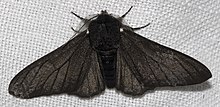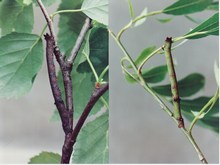Moth moth
| Moth moth | ||||||||||||
|---|---|---|---|---|---|---|---|---|---|---|---|---|

Black moth ( Biston betularia ) |
||||||||||||
| Systematics | ||||||||||||
|
||||||||||||
| Scientific name | ||||||||||||
| Biston betularia | ||||||||||||
| ( Linnaeus , 1758) |
The peppered moth ( Biston betularia ) is a butterfly ( moth ) from the family of the tensioner (Geometridae).
description
The moth is of a white basic color with black markings and is therefore particularly well camouflaged in the branches of a birch. The nocturnal insect can reach a wingspan of up to 55 millimeters.
Similar species
- Poplar bellybones ( Biston strataria ) (Hufnagel, 1767)
Subspecies
Various subspecies are known from East Asia , Central Asia and Transcaucasia .
to form
- Biston betularia f. carbonaria : The theory that in areas of England with heavy sooting and therefore darker, poor lichen birch trunks, the darker form predominates (" industrial melanism ") is controversial.
Flight time
The species forms one generation each year that flies from May to August.
habitat
The spotted moth inhabits floodplain, quarry and mixed deciduous forests and the adjacent border areas, rich in bushes. It can also be observed in cultivated or abandoned cultivated land, including densely built-up settlement areas.
Way of life
The species feeds on a very polyphagous diet ; the butterfly lays its eggs on the leaves of hardwoods, mostly poplar ( Populus spec.), Birch ( Betula spec.), Willow ( Salix spec.) Or oak ( Quercus spec.). Ebert lists 45 different plant species for Baden-Württemberg alone . The green to brownish caterpillar feeds on the leaves. The pupation occurs in the earth.
distribution
The distribution area of the black moth extends from the Iberian Peninsula through all of Europe as well as over the temperate zones of East Asia . The north-south distribution extends from the Mediterranean and Asia Minor to central Fennoscandia . The moth is also common in North America .
Others
Analyzes of the genetic material and gene expression showed that moth caterpillars perceive the color of their environment with both their eyes and their skin - and actively adapt to it by forming the pigment melanin . Active, genetically engineered adaptation affects both the shape and color and texture of the environment and the forage plants. The genes responsible for perceiving the environment are read even more strongly in the skin than in the eyes. In contrast, it has been believed since the 19th century that moths would adapt their color to their surroundings over generations.
See also
swell
Individual evidence
- ^ A b Günter Ebert, Daniel Bartsch, Armin Becher, Stefan Hafner: The butterflies of Baden-Württemberg Volume 9 (Spanner (Geometridae) 2nd part), Nachtfalter VII. Ulmer Verlag, Stuttgart 2003, ISBN 3-800-13279-6 .
- ↑ Eacock, A., Rowland, HR, van't Hof, AE, Yung, C., Edmonds, N., Saccheri, IJ: Caterpillars of the peppered moth perceive color through their skin to match their body color to the background . August 2019. Retrieved August 2, 2019.
literature
- Michael Chinery: Parey's Book of Insects. A field guide of European insects. Translated from the English by Irmgard Jung. Franckh-Kosmos, Stuttgart 2004, ISBN 3-440-09969-5 .
- Ursula Stichmann-Marny (Hrsg.): The new cosmos animal and plant guide . Franckh-Kosmos Verlags-GmbH & Co., Stuttgart 2000, ISBN 3-440-08847-2 .
Web links
- Lepiforum e. V. Taxonomy and Photos
- www.schmetterling-raupe.de
- Moths and Butterflies of Europe and North Africa (English)
- Biston betularia at Fauna Europaea


